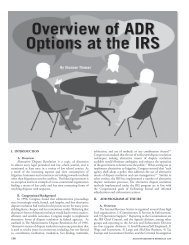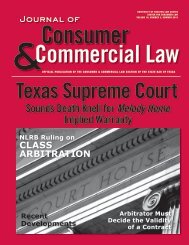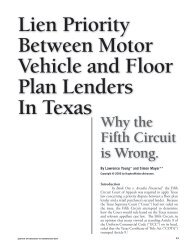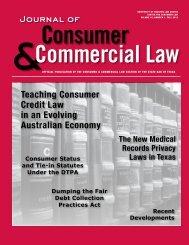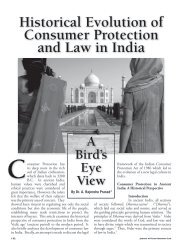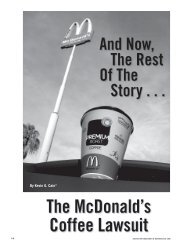Insurance - Journal of Comsumer & Commercial Law
Insurance - Journal of Comsumer & Commercial Law
Insurance - Journal of Comsumer & Commercial Law
You also want an ePaper? Increase the reach of your titles
YUMPU automatically turns print PDFs into web optimized ePapers that Google loves.
RECENT DEVELOPMENTS<br />
stated that the Stowers duty does not arise for an excess insurer<br />
until the primary carrier has tendered its limits. Keck v. Nat’l<br />
Union Fire Ins. Co., 20 S.W.3d 692 (Tex 2000). In Westchester,<br />
this court concluded that an excess insurer was not entitled to<br />
equitable subrogation against a primary insurer from breach <strong>of</strong><br />
its Stowers duty when the initial settlement demand exceeded the<br />
limits <strong>of</strong> the primary policy. Westchester Fire Ins. Co. v. American<br />
Contractors Ins. Co. Risk Retention Group, 1 S.W.3d 874 (Tex.<br />
App. Houston 1st Dist. 1999).<br />
In reviewing the claim against Southern, this court stated<br />
the settlement <strong>of</strong>fer did not state a release <strong>of</strong> claims against the<br />
Plaintiffs under a particular policy and the settlement demand<br />
was a sum that exceeded Southern policy’s limits and was an aggregation<br />
<strong>of</strong> multiple policies. See Mid-Continent Ins. Co., 236<br />
S.W.3d at 776. Thus, the trial court correctly granted summary<br />
judgment in favor <strong>of</strong> Southern. In reviewing the claim against<br />
Acceptance, the court stated that the primary carrier never tendered<br />
its policy limits and the trial court also correctly granted<br />
summary judgment in favor <strong>of</strong> Acceptance in accordance to the<br />
rulings in Keck and Westchester. So, the court concluded that the<br />
settlement demands by the personal injury plaintiffs never triggered<br />
the insurers’ Stowers duties. The settlement terms required<br />
funding from multiple insurers, and no single insurer could fund<br />
the settlement within the limits that applied under its particular<br />
policy.<br />
TEXAS STANDARD HOMEOWNER’S POLICY COVERS<br />
MOLD DAMAGE TO PERSONAL PROPERTY BUT NOT<br />
DWELLING<br />
State Farm Lloyds and Erin Strachan v. Wanda M. Page, 315<br />
S.W.3d 525 (Tex. 2010).<br />
FACTS: Page (“Homeowner”) discovered damage to her home<br />
and personal property from mold and water damage. Homeowner<br />
then proceeded to file a claim with State Farm (“insurer”) as<br />
directed by her homeowner’s policy, the Texas Standard Homeowner’s<br />
Policy-Form B (“HO-B”). Testing was performed by the<br />
insurer, and it was revealed that the mold came from a plumbing<br />
leak. Insurer covered homeowner’s cost to remediate and repair<br />
the structure, and an amount to cover personal property remediation<br />
and three months <strong>of</strong> living expenses while work was performed.<br />
Homeowner then requested an additional amount to repair<br />
her damaged carpet. Insurer refused, arguing that the HO-B<br />
policy expressly excludes mold damage coverage. The trial court<br />
granted insurer’s motion for summary judgment. The court <strong>of</strong><br />
appeals reversed, holding that homeowner’s HO-B policy covered<br />
both the dwelling and its contents.<br />
HOLDING: Affirmed in part, reversed in part, and remanded.<br />
REASONING: In their opinion, the court looks at its prior rulings<br />
regarding their interpretation <strong>of</strong> the HO-B policy to determine<br />
whether the 1(f) rust, rot, mold, or other fungi exclusion<br />
applies to dwellings under Coverage A or personal property under<br />
Coverage B. In determining the meaning <strong>of</strong> the provision, the<br />
court read the contract in its entirety, instead <strong>of</strong> isolating each individual<br />
section. This allows a fuller understanding <strong>of</strong> the parties’<br />
intent. Coverage A <strong>of</strong> the HO-B policy provides dwelling insurance<br />
against all risks <strong>of</strong> physical loss unless the loss is excluded<br />
under Section I Exclusions. Coverage B(9) <strong>of</strong> the HO-B policy<br />
provides personal property insurance against accidental discharge,<br />
leaking or overflow <strong>of</strong> water or steam from within a plumbing.<br />
The “exclusion repeal provision” listed under this coverage provides<br />
an exception for exclusions that do not apply to loss caused<br />
by Coverage B(9).<br />
The court determined the policy meaning by reading the<br />
exclusion repeal provision in conjunction with the coverage provisions.<br />
There appeared to be no ambiguity when the provisions<br />
were read together. The court in Fiess took a liberal interpretation<br />
<strong>of</strong> the same policy to exclude all damages that result from mold<br />
contamination <strong>of</strong><br />
dwellings. The court<br />
at that time did not<br />
rule on whether 1(f)<br />
applied to personal<br />
property. The exclusion<br />
repeals provision<br />
states that “Exclusions<br />
1.a. through<br />
1.h. under Section<br />
I Exclusions do not<br />
apply to loss caused<br />
In their opinion, the court<br />
looks at its prior rulings<br />
regarding their interpretation<br />
<strong>of</strong> the HO-B policy to<br />
determine whether the 1(f)<br />
rust, rot, mold, or other<br />
fungi exclusion applies to<br />
dwellings under Coverage A<br />
or personal property under<br />
Coverage B.<br />
by this peril.” The<br />
only reasonable interpretation<br />
would<br />
be to limit the exclusion<br />
repeal provision<br />
to personal property. The plain language <strong>of</strong> the Section I Exclusions<br />
sates that the exclusions listed apply to both Coverage A<br />
(Dwelling) and Coverage B (Personal Property). If the exclusion<br />
repeal provision was intended to reinstate the mold exclusion<br />
(1.f) back into coverage under both Coverage A and Coverage<br />
B, this would make the entire mold exclusion useless. The only<br />
way to make sense <strong>of</strong> the provision would be to limit the mold<br />
exclusion to personal property. Since the exclusion repeal provision<br />
falls under the “Accidental Discharge, Leaking or Overflow<br />
<strong>of</strong> Water or Steam from within a plumbing, heating or air conditioning<br />
system or household appliance” peril, the mold exclusion<br />
would reinstate mold coverage for plumbing leaks that damage<br />
personal property. The court held that the HO-B policy covered<br />
mold damage from a plumbing leak to personal property, but it<br />
did not cover mold damage to the dwelling.<br />
36 <strong>Journal</strong> <strong>of</strong> Consumer & <strong>Commercial</strong> <strong>Law</strong>



